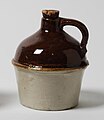
Fiesta is a line of ceramic glazed dinnerware manufactured and marketed by the Homer Laughlin China Company of Newell, West Virginia since its introduction in 1936, with a hiatus from 1973 to 1985. Fiesta is noted for its Art Deco styling featuring concentric circles—and its range of solid colors.
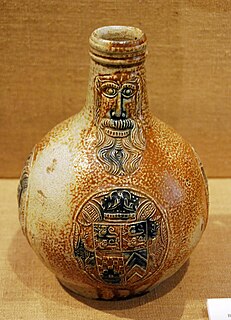
Salt-glaze or salt glaze pottery is pottery, usually stoneware, with a glaze of glossy, translucent and slightly orange-peel-like texture which was formed by throwing common salt into the kiln during the higher temperature part of the firing process. Sodium from the salt reacts with silica in the clay body to form a glassy coating of sodium silicate. The glaze may be colourless or may be coloured various shades of brown, blue, or purple.
North Dakota in the United States has been the scene of modern era pottery production using North Dakota clays since the early 1900s. In 1892 a study was published by Earle Babcock, a chemistry instructor at the University of North Dakota (UND) that reported on the superior qualities of some of the North Dakota clays for pottery production. The UND School of Mines began operations in 1898 with Earle Babcock as director. With the assistance of several eastern potteries, pottery made from North Dakota clay was first displayed at the 1904 St. Louis World's Fair.

Langley Mill Pottery was located in Langley Mill, Derbyshire on the Derbyshire – Nottinghamshire border. From its establishment in 1865 to its final closure in 1982, the pottery went through five distinct periods of ownership, producing a wide range of stoneware ranging from salt glazed ink bottles, utilitarian items and tableware to high quality and original art pottery.

Royal Doulton is an English ceramic and home accessories manufacturer founded in 1815. Operating originally in Vauxhall, London, later moving to Lambeth, in 1882 it opened a factory in Burslem, Stoke-on-Trent, in the centre of English pottery. From the start the backbone of the business was a wide range of utilitarian wares, mostly stonewares, including storage jars, tankards and the like, and later extending to pipes for drains, lavatories and other bathroom ceramics. From 1853 to 1902 its wares were marked Doulton & Co., then from 1902, when a royal warrant was given, Royal Doulton.

The Hall China Company is an American ceramics manufacturer located in East Liverpool, Ohio, United States, known for pioneering the single-fire glazing process.
The Homer Laughlin China Company is a ceramics manufacturer located in Newell, West Virginia, United States, established in 1871 and widely known for its retail dinnerware line, Fiesta. Since the late 1950s, the two brand had marketed its retail lines as well as separate lines for the food service industry. In 2010, the company acquired the nearby Hall China Company.

Art pottery is a term for pottery with artistic aspirations, made in relatively small quantities, mostly between about 1870 and 1930. Typically, sets of the usual tableware items are excluded from the term; instead the objects produced are mostly decorative vessels such as vases, jugs, bowls and the like which are sold singly. The term originated in the later 19th century, and is usually used only for pottery produced from that period onwards. It tends to be used for ceramics produced in factory conditions, but in relatively small quantities, using skilled workers, with at the least close supervision by a designer or some sort of artistic director. Studio pottery is a step up, supposed to be produced in even smaller quantities, with the hands-on participation of an artist-potter, who often performs all or most of the production stages. But the use of both terms can be elastic. Ceramic art is often a much wider term, covering all pottery that comes within the scope of art history, but "ceramic artist" is often used for hands-on artist potters in studio pottery.

J.A. Bauer Pottery is an American pottery that was founded in Paducah, Kentucky in 1895 and operated for most of its life in Los Angeles, California. It closed in 1962.
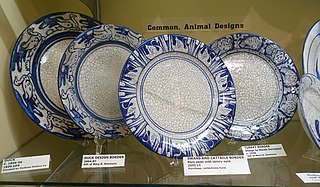
Dedham Pottery was an American art pottery company opened by the Robertson Family in Dedham, Massachusetts during the American arts & crafts movement that operated between 1896 and 1943. It was known for its high-fire stoneware characterized by a controlled and very fine crackle glaze with thick cobalt border designs. The Chelsea Keramic Art Works (1872–1889) and "Chelsea Pottery U.S." were earlier companies of the family.

Franciscan Ceramics are ceramic tableware and tile products produced by Gladding, McBean & Co. in Los Angeles, California, from 1934–1962, International Pipe and Ceramics (Interpace) from 1962–1979, and Wedgwood from 1979-1983. Wedgwood closed the Los Angeles plant, and moved the production of dinnerware to England in 1983. Waterford Glass Group plc purchased Wedgwood in 1986, becoming Waterford Wedgwood. KPS Capital Partners acquired all of the holdings of Waterford Wedgwood in 2009. The Franciscan brand became part of a group of companies known as WWRD, an acronym for "Wedgwood Waterford Royal Doulton." WWRD continues to produce the Franciscan patterns Desert Rose and Apple.

Pacific Clay Products, founded 1892, was created by the merger of several Southern California potteries. The company began producing utilitarian pottery in the 1920s, and introduced solid color earthenware dinnerware in 1932. The primary site for the production of ceramic tableware, kitchenware, and art ware was based in the company's Lincoln Heights, Los Angeles plant at 306 West Avenue 26. Pacific Clay ceased production of ceramic dinnerware and art ware in 1942. After 1942, Pacific Clay produced sewer tile and brick. The company ceased production of sewer tile in 1997. The company continues to produce brick products in Lake Elsinore, California. The company has been owned by David H. Murdock since 1973.

Vernon Kilns was an American ceramic company in Vernon, California. In July 1931, Faye G. Bennison purchased the former Poxon China pottery renaming the company Vernon Kilns. Poxon China was located at 2300 East 52nd Street. Vernon produced ceramic tableware, art ware, giftware, and figurines. The company closed its doors in 1958.
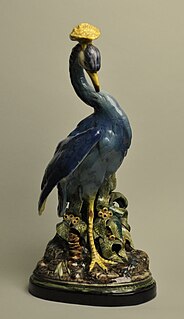
California pottery includes industrial, commercial, and decorative pottery produced in the Northern California and Southern California regions of the U.S. state of California. Production includes brick, sewer pipe, architectural terra cotta, tile, garden ware, tableware, kitchenware, art ware, figurines, giftware, and ceramics for industrial use. Ceramics include terra cotta, earthenware, porcelain, and stoneware products.

The Shawnee Pottery Company was a manufacturing company best known for producing Corn King pottery and the Pennsylvania Dutch lines of pottery. Both of these lines are considered to be highly collectible.
George Rumrill was an American potter. He started RumRill Pottery. His work was popular in the 1920s. Georgine Mickler was his daughter. After her mother died she was raised by an aunt.
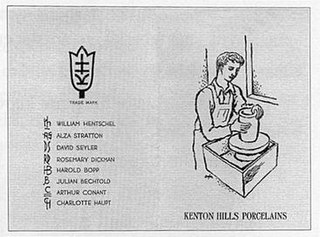
Kenton Hills Porcelains were high-fired soft paste porcelain products manufactured by Kenton Hills Porcelains, Inc. Ceramics were produced from 1940 to 1943 in Erlanger, Kentucky, with sales continuing to 1944. All ceramic products were made from native clays. Products include vases, bookends, figurines, lamp bases, and flowerpots.

Brayton Laguna Pottery produced ceramics (pottery) in Laguna Beach, California from 1927 to 1968.

American art pottery refers to aesthetically distinctive hand-made ceramics in earthenware and stoneware from the period 1870-1950s. Ranging from tall vases to tiles, the work features original designs, simplified shapes, and experimental glazes and painting techniques. Stylistically, most of this work is affiliated with the modernizing Arts and Crafts (1880-1910), Art Nouveau (1890–1910), or Art Deco (1920s) movements, and also European art pottery.
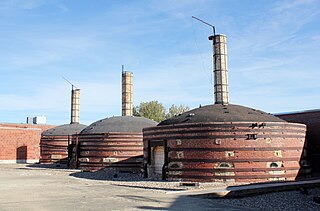
The Medalta Potteries was a Canadian ceramics manufacturing company in Medicine Hat, Alberta, that operated from 1916 to 1954. It was the first manufacturer in Western Canada to ship its products east of Ontario.





